Remote Sensing Monitoring of Advancing and Surging Glaciers in the Tien Shan, 1990–2019
Abstract
1. Introduction
2. Materials and Methods
2.1. Study Area
2.2. Data Sources
2.3. Methods
2.3.1. Glacial Boundary Extraction
2.3.2. Glacier Length Extraction
2.3.3. Glacier Surface Elevation Calculation
2.3.4. Identification of Advancing and Surging Glaciers
3. Results
3.1. Terminal Advancing Glaciers
3.2. Surging Glaciers
3.3. Surface Advancing Glaciers
4. Discussion
4.1. The Relationship between Advancing, Surging Glaciers, and Climate Change in the Tien Shan
4.2. Periodicity of Surging Glaciers in the Tien Shan
4.3. The Occurrence Mechanism of Surging Glaciers in the Tien Shan
4.4. Comparison with Surging Glaciers in Other Regions of High Asia
4.5. Disaster Assessment of Surging or Advancing Glaciers in the Tien Shan Region
5. Conclusions
Author Contributions
Funding
Conflicts of Interest
References
- Shi, Y.F.; Cheng, G.D. The cryosphere and global change. Bull. Chin. Acad. Sci. 1991, 4, 287–291. [Google Scholar] [CrossRef]
- Grinsted, A. An estimate of global glacier volume. Cryosphere 2013, 7, 141–151. [Google Scholar] [CrossRef]
- Qin, D.H.; Ding, Y.J. Key Issues on Cryospheric Changes, Trends and Their Impacts. Adv. Clim. Chang. Res. 2010, 1, 1–10. [Google Scholar] [CrossRef]
- Shi, Y.F.; Liu, S.Y. Estimation on the response of glaciers in China to the global warming in the 21st century. Sci. Bull. 2000, 45, 668–672. [Google Scholar] [CrossRef]
- Yao, T.D. Glacial fluctuations and its impacts on lakes in the southern Tibetan Plateau. Sci. Bull. 2010, 55, 2071. [Google Scholar] [CrossRef]
- Farinotti, D.; Immerzeel, W.W.; Kok, R.J.D.; Quincey, D.J.; Dehecq, A. Manifestations and mechanisms of the Karakoram glacier Anomaly. Nat. Geosci. 2020, 13, 8–16. [Google Scholar] [CrossRef] [PubMed]
- Hewitt, K. The Karakoram anomaly? Glacier expansion and the ‘elevation effect’, Karakoram Himalaya. Mt. Res. Dev. 2005, 25, 332–340. [Google Scholar] [CrossRef]
- Cogley, G. No ice lost in the Karakoram. Nat. Geosci. 2012, 5, 305–306. [Google Scholar] [CrossRef]
- Yao, T.D.; Yu, W.S.; Wu, G.J.; Xu, B.Q.; Yang, W.; Zhao, H.B.; Wang, W.C.; Li, S.H.; Wang, N.L.; Li, Z.Q.; et al. Glacier anomalies and relevant disaster risks on the Tibetan Plateau and surroundings. Sci. Bull. 2019, 64, 2770–2782. [Google Scholar] [CrossRef]
- Meier, M.F.; Post, A. What are glacier surges? Can. J. Earth. Sci. 1969, 6, 807–814. [Google Scholar] [CrossRef]
- Zhang, Z.; Liu, S.Y.; Wei, J.F.; Jiang, Z.L.; Xu, J.L.; Guo, W.Q. Monitoring recent surging of the Karayaylak Glacier in Pamir by remote sensing. J. Glaciol. Geocryol. 2016, 38, 11–20. [Google Scholar] [CrossRef]
- Jiskoot, H.; Murray, T.; Luckman, A. Surge potential and drainage basin characteristics in East Greenland. Ann. Glaciol. 2003, 36, 142–148. [Google Scholar] [CrossRef]
- Copland, L.; Sharp, M.J.; Dowdeswell, J.A. The distribution and flow characteristics of surge-type glaciers in the Canadian High Arctic. Ann. Glaciol. 2003, 36, 73–81. [Google Scholar] [CrossRef]
- Gardner, J.S. A surge of Bualtar Glacier, Karakoram Range, Pakistan: A possible landslide trigger. J. Glaciol. 1990, 36, 159–162. [Google Scholar] [CrossRef]
- Barrand, N.E.; Murray, T. Multivariate controls on the incidence of glacier surging in the Karakoram Himalaya. Arct. Antarct. Alp. Res. 2006, 38, 489–498. [Google Scholar] [CrossRef]
- Hewitt, K. Tributary glacier surges: An exceptional concentration at Panmah Glacier, Karakoram Himalaya. J. Glaciol. 2007, 53, 181–188. [Google Scholar] [CrossRef]
- Quincey, D.J.; Braun, M.; Glaser, N.F.; Bishop, M.P.; Hewitt, K.; Luckman, A. Karakoram glacier surge dynamics. Geophys. Res. Lett. 2011, 38, L18504. [Google Scholar] [CrossRef]
- Wu, K.; Liu, S.; Jiang, Z.; Zhu, Y.; Xie, F.; Gao, Y.; Yi, Y.; Tahir, A.A.; Muhammad, S. Surging Dynamics of Glaciers in the Hunza Valley under an Equilibrium Mass State since 1990. Remote Sens. 2020, 12, 2922. [Google Scholar] [CrossRef]
- Osipova, G.B.; Tsetkov, D.G.; Rudak, M.S. Inventory of the Pamirs surging glaciers. Data. Glac. Stud. 1998, 85, 3–136. [Google Scholar]
- Kotlyakov, V.M.; Osipova, G.V.; Tsvetkov, D.G. Monitoring surging glaciers of the Pamirs, Central Asia from space. Ann. Glaciol. 2008, 48, 125–134. [Google Scholar] [CrossRef]
- Yasuda, T.; Furuya, M. Dynamics of surge-type glaciers in West Kunlun Shan, Northwestern Tibet. J. Geophys. Res. Earth 2016, 120, 2393–2405. [Google Scholar] [CrossRef]
- Muhammad, S.; Tian, L. Mass balance and a glacier surge of Guliya ice cap in the western Kunlun Shan between 2005 and 2015. Remote Sens. Environ. 2020, 244, 111832. [Google Scholar] [CrossRef]
- Evans, S.G.; Tutubalina, O.V.; Drobyshev, V.N.; Chernomomorets, S.S.; McDougall, S.; Petrakov, D.A.; Hungr, O. Catastrophic detachments and high-velocity long-runout flow of Kolka Glacier, Caucasus Mountains, Russia in 2002. Geomorphology 2009, 105, 314–321. [Google Scholar] [CrossRef]
- Richardson, S.D.; Reynolds, J.M. An overview of glacial hazards in the Himalayas. Quatern. Int. 2000, 65, 31–47. [Google Scholar] [CrossRef]
- Ding, M.; Huai, B.; Sun, W.; Wang, Y.; Zhang, D.; Guo, X.; Zhang, T. Surge-type glaciers in Karakoram Mountain and possible catastrophes alongside a portion of the Karakoram Highway. Nat. Hazards 2018, 90, 1017–1020. [Google Scholar] [CrossRef]
- Hewitt, K.; Liu, J. Ice-dammed lakes and outburst floods, Karakoram Himalaya: Historical perspectives on emerging threats. Phys. Geogr. 2010, 31, 528–551. [Google Scholar] [CrossRef]
- Rashid, I.; Majeed, U.; Jan, A.; Glasser, N. The January 2018 to September 2019 surge of Shisper Glacier, Pakistan, detected from remote sensing observations. Geomorphology 2020, 351, 106957. [Google Scholar] [CrossRef]
- Yang, X.H.; Zhao, J.D.; Han, H. Study on glacier mass balance in the Karlik Range, East Tianshan Mountains, 1972–2016. J. Glaciol. Geocryol. 2019, 41, 1–11. [Google Scholar] [CrossRef]
- Che, Y.J.; Zhang, M.J.; Li, Z.Q.; Jin, S.; Wang, W.B.; Wang, S.J. Understanding the mass balance characteristics of Qingbingtan Glacier No. 72 during the period of 2008–2014. J. Glaciol. Geocryol. 2020, 42, 318–331. [Google Scholar] [CrossRef]
- Huai, B.; Sun, W.; Wang, Y.; Li, Z. Glacier Shrinkage in the Chinese Tien Shan Mountains from 1959/1972 to 2010/2012. Arct. Antarct. Alp. Res. 2017, 49, 213–225. [Google Scholar] [CrossRef][Green Version]
- Wang, L.; Wang, F.; Li, Z.; Wang, W.; Li, H.; Wang, P. Glacier changes in the Sikeshu River basin, Tienshan Mountains. Quatern. Int. 2015, 358, 153–159. [Google Scholar] [CrossRef]
- Xing, W.C.; Li, Z.Q.; Zhang, H.; Zhang, M.J.; Liang, P.B.; Mu, J.X. Spatial-temporal variation of glacier resources in Chinese Tianshan Mountains since 1959. J. Geogr. Sci. 2017, 72, 1594–1605. [Google Scholar] [CrossRef]
- Wang, P.Y.; Li, Z.Q.; Wu, L.H.; Li, H.L.; Wang, W.B.; Jin, S.; Zhou, P. Ice Thickness and Volume Based on GPR, GPS and GIS: Example from the Heigou Glacier No.8, Bogda-Peak Region, Tianshan, China. Earth Sci. 2012, 37, 179–187. [Google Scholar] [CrossRef]
- Xie, Z.C.; Liu, C.H. Introduction to Glaciology; Shanghai Science Popular Press: Shanghai, China, 2010; pp. 425–426. [Google Scholar]
- Häusler, H.; Ng, F.; Kopency, A.; Leber, D. Remote-sensing-based analysis of the 1996 surge of Northern Inylchek Glacier, central Tien Shan, Kyrgyzstan. Geomorphology 2016, 273, 292–307. [Google Scholar] [CrossRef]
- Mukherjee, K.; Bolch, T.; Goerlich, F.; Kutuzov, S.; Osmonov, A.; Pieczonka, T.; Shesterova, I. Surge-type glaciers in the Tien Shan (Central Asia). Arct. Antarct. Alp. Res. 2017, 49, 147–171. [Google Scholar] [CrossRef]
- Liu, C.H.; Ding, L.F. A primary calculation of temperature and precipitation in Tianshan Mountains, China. J. Glaciol. Geocryol. 1988, 10, 151–159. [Google Scholar]
- Hu, R. Physical Geography of the Tianshan Mountains in China; China Environmental Science Press: Beijing, China, 2004. [Google Scholar]
- Chen, Y.; Li, W.; Deng, H.; Fang, G.; Li, Z. Changes in central Asia’s water tower: Past, Present and Future. Sci. Rep. 2016, 6, 35458. [Google Scholar] [CrossRef]
- RGI Consortium. Randolph Glacier Inventory—A Dataset of Global Glacier Outlines: Version 6.0: Technical Report, Global Land Ice Measurements from Space; Digital Media: Denver, CO, USA, 2017. [Google Scholar] [CrossRef]
- Liu, S.Y.; Guo, W.Q.; Xu, J.L. The Second Glacier Inventory Dataset of China (Version 1.0) (2006–2011); National Tibetan Plateau Data Center: Beijing, China, 2012. [Google Scholar] [CrossRef]
- Paul, F.; Kääb, A.; Maisch, M.; Tobias, K.; Haeberli, W. The new remote-sensing-derived Swiss glacier inventory: I. Methods. Ann. Glaciol. 2002, 34, 355–361. [Google Scholar] [CrossRef]
- Yao, X.J.; Liu, S.Y.; Guo, W.Q.; Huai, B.J.; Sun, M.P.; Xu, J.L. Glacier Change of Altay Mountain in China from 1960 to 2009—Based on the Second Glacier Inventory of China. J. Nat. Resour. 2012, 27, 1734–1745. [Google Scholar] [CrossRef]
- Paul, F.; Barrand, N.E.; Baumann, S.; Berthier, E.; Bolch, T.; Casey, K.; Frey, H.; Joshi, S.P.; Konovalov, V.; Le Bris, R.; et al. On the accuracy of glacier outlines derived from remote-sensing data. Ann. Glaciol. 2013, 54, 171–182. [Google Scholar] [CrossRef]
- He, Y.; Yang, T.B. Climate variation and glacier response in the Bogda Region, Tianshan Mountains. Prog. Geogr. 2014, 33, 1387–1396. [Google Scholar] [CrossRef]
- Wu, K.P.; Liu, S.Y.; Bao, W.J.; Wang, R.J. Remote sensing monitoring of the glacier change in the Gangrigabu Range, Southeast Tibetan Plateau from 1980 through 2015. J. Glaciol. Geocryol. 2017, 39, 24–34. [Google Scholar] [CrossRef]
- Guo, W.Q.; Liu, S.Y.; Xu, J.L.; Wu, L.Z.; Shangguan, D.H.; Yao, X.J.; Wei, J.F.; Bao, W.J.; Yu, P.C.; Liu, Q.; et al. The second Chinese glacier inventory: Data, methods and results. J. Glaciol. 2015, 61, 357–372. [Google Scholar] [CrossRef]
- Machguth, H.; Huss, M. The length of the world’s glaciers—A new approach for the global calculation of center lines. Cryosphere 2014, 8, 1741–1755. [Google Scholar] [CrossRef]
- Wang, P.Y.; Li, Z.Q.; Cao, M.; Li, H.L. Variation of Qingbingtan Glacier No.72 in Mountain Tuomuer region during past 45 years. Sci. Geogr. Sin. 2010, 30, 962–967. [Google Scholar] [CrossRef]
- Guo, W.Q.; Liu, S.Y.; Xu, J.L.; Wei, J.F.; Ding, L.F. Monitoring recent surging of the Yulinchuan Glacier on north slopes of Muztag range by remote sensing. J. Glaciol. Geocryol. 2012, 34, 765–774. [Google Scholar]
- Le Bris, R.; Paul, F. An automatic method to create flow lines for determination of glacier length: A pilot study with Alaskan glaciers. Comput. Geosci. UK 2013, 52, 234–245. [Google Scholar] [CrossRef]
- Kienholz, C.; Rich, J.L.; Arendt, A.A.; Hock, R. A new method for deriving glacier centerlines applied to glaciers in Alaska and northwest Canada. Cryosphere 2014, 8, 503–519. [Google Scholar] [CrossRef]
- Yang, B.Y.; Zhang, L.G.; Gao, Y.; Xiang, Y.; Mou, N.X.; Suolang, D.B. An integrated method of glacier length extraction based on Gaofen satellite data. J. Glaciol. Geocryol. 2016, 38, 1615–1623. [Google Scholar] [CrossRef]
- Yao, X.J.; Liu, S.Y.; Zhu, Y.; Gong, P.; An, L.N.; Li, X.F. Design and implementation of an automatic method for deriving glacier centerlines based on GIS. J. Glaciol. Geocryol. 2015, 37, 1563–1570. [Google Scholar] [CrossRef]
- Zhang, D.H.; Yao, X.J.; Duan, H.Y.; Liu, S.Y.; Guo, W.Q.; Sun, M.P.; Li, D.Z. A new automatic approach for extracting glacier centerlines based on Euclidean allocation. Cryosphere 2021, 15, 1955–1973. [Google Scholar] [CrossRef]
- Zhang, Z.; Liu, S.Y.; Wei, J.F.; Jiang, Z.L. Monitoring a glacier surge in the Kungey Mountain, eastern Pamir Plateau using remote sensing. Prog. Geogr. 2018, 37, 1545–1554. [Google Scholar] [CrossRef]
- Jiang, Z.; Liu, S.; Guo, W.; Li, J.; Long, S.; Wang, X.; Wei, J.; Zhang, Z.; Wu, K. Recent surface elevation changes of three representative glaciers in Ányêmaqên Mountains, source regions of Yellow River. J. Glaciol. Geocryol. 2018, 40, 231–237. [Google Scholar] [CrossRef]
- Bolch, T.; Pieczonka, T.; Benn, D.I. Multi-decadal mass loss of glaciers in the Everest area (Nepal Himalaya) derived from stereo imagery. Cryosphere 2011, 5, 349–358. [Google Scholar] [CrossRef]
- Lv, M.; Guo, H.; Yan, J.; Wu, K.; Liu, G.; Lu, X.; Ruan, Z.; Yan, S. Distinguishing Glaciers between Surging and Advancing by Remote Sensing: A Case Study in the Eastern Karakoram. Remote Sens. 2020, 12, 2297. [Google Scholar] [CrossRef]
- Rankl, M.; Kienholz, C.; Braun, M. Glacier changes in the Karakoram region mapped by multimission satellite imagery. Cryosphere 2014, 8, 4065–4099. [Google Scholar] [CrossRef]
- Shangguan, D.H.; Bolch, T.; Ding, Y.J.; Elias, M.; Pieczonka, T.; Wetzel, H.U.; Liu, S.Y. Mass changes of Southern and Northern Inylchek Glacier, Central Tian Shan, Kyrgyzstan, during~1975 and 2007 derived from remote sensing data. Cryosphere 2015, 9, 703–717. [Google Scholar] [CrossRef]
- Shi, Y.F. A Concise China Glacier Inventory; Shanghai Science Popular Press: Shanghai, China, 2005. [Google Scholar]
- Eisen, O.; Harrison, W.D.; Raymond, C.F. The surges of Variegated Glacier, Alaska, U.S.A., and their connection to climate and mass balance. J. Glaciol. 2001, 47, 351–358. [Google Scholar] [CrossRef]
- Striberger, J.; Björck, S.; Benediktsson, I.O.; Snowball, I.; Uvo, C.B.; Ingólfsson, O.; Kjaer, K.H. Climatic control of the surge periodicity of an Icelandic outlet glacier. J. Quat. Sci. 2011, 26, 561–565. [Google Scholar] [CrossRef]
- Kochtitzky, W.; Jiskoot, H.; Copland, L.; Enderlin, E.; Main, B. Terminus advance, kinematics, and mass redistribution during eight surges of Donjek Glacier, St. Elias Range, Canada, from 1935 to 2016. J. Glaciol. 2019, 65, 565–579. [Google Scholar] [CrossRef]
- Gao, Y.P.; Yao, X.J.; Liu, S.Y.; Qi, M.M.; Duan, H.Y.; Liu, J.; Zhang, D.H. Remote sensing monitoring of advancing glaciers in the Bukatage Mountains from 1973 to 2018. J. Nat. Resour. 2019, 34, 1666–1681. [Google Scholar] [CrossRef]
- Duan, J.P.; Wang, L.L.; Ren, J.W.; Li, L. Progress in glacier variations in China and its sensitivity to climatic change during the past century. Prog. Geogr. 2009, 28, 231–237. [Google Scholar] [CrossRef]
- Björnsson, H.; Pálsson, F.; Sigurđsson, O.; Flowers, G. Surges of glaciers in Iceland. Ann. Glaciol. 2003, 36, 82–90. [Google Scholar] [CrossRef]
- Mavlyudov, B.R. Kolebanja jasyka lednika Severnyj Inylchek (Tongue oscillations of Northern Inylchek Glacier). Data Glaciol. Stud. 1995, 79, 95–98. [Google Scholar]
- Pieczonka, T.; Bolch, T. Region-wide glacier mass budgets and area changes for the Central Tien Shan between 1975 and 1999 using Hexagon KH-9 imagery. Glob. Planet. Chang. 2015, 128, 1–13. [Google Scholar] [CrossRef]
- Osmonov, A.; Bolch, T.; Xi, C.; Kurban, A.; Guo, W. Glaciers characteristics and changes in the Sary-Jaz River Basin (Central Tien Shan, Kyrgyzstan) 1990–2010. Remote Sens. Lett. 2013, 4, 725–734. [Google Scholar] [CrossRef]
- Bondarev, L.G.; Zabirov, R.D. Kolebanie lednikov bnutrennego Tian Shania v poslednie desiatiletia (Fluctuations of glaciers in inner Tien Shan over recent decades). Data Glaciol. Stud. 1964, 9, 125–130. [Google Scholar]
- Dyurgerov, M.B.; Liu, C.; Xie, Z. Oledenenie Tian Shania (Tien Shan Glaciation); Viniti: Moscow, Russia, 1995; p. 237. [Google Scholar]
- Osmonov, A. Lednik Mushketova (Mushketov glacier). Proc. Kyrg. SSR Geogr. Soc. 1968, 7, 24–29. [Google Scholar]
- Clarke, G.K.C.; Schmok, J.P.; Ommanney, C.S.L. Characteristics of surge-type glaciers. J. Geophys. Res. Sol. Earth 1986, 8, 197. [Google Scholar] [CrossRef]
- Dunse, T.; Schellenberger, T.; Hagen, J.O.; Kääb, A.; Reijmer, C.H. Glacier-surge mechanisms promoted by a hydro-thermodynamic feedback to summer melt. Cryosphere 2015, 9, 197–215. [Google Scholar] [CrossRef]
- Quincey, D.J.; Glasser, N.F.; Cook, S.J.; Luckman, A. Heterogeneity in Karakoram glacier surges. J. Geophys. Res. Earth 2015, 120, 1288–1300. [Google Scholar] [CrossRef]
- Robin, G.D.Q.; Weertman, J. Cyclic surging of glaciers. J. Glaciol. 1973, 12, 3–18. [Google Scholar] [CrossRef][Green Version]
- Clarke, G.K.C.; Nitsan, U.; Paterson, W.S.B. Strain heating and creep instability in glaciers and ice sheets. Rev. Geophys. 1977, 15, 235–247. [Google Scholar] [CrossRef]
- Rototaeva, O.B.; Kotlyakov, V.M.; Nosenko, G.A. Historical information on surges of pulsing glaciers in the Northern Caucasus and Karmadon catastrophe 2002. Data Glaciol. Stud. 2005, 98, 136–146. [Google Scholar]
- Kamb, B.; Raymond, C.F.; Harrison, W.D.; Engelhardt, H.; Echelmeyer, K.A.; Humphrey, N.; Brugman, M.M.; Pfeffer, T. Glacier surge mechanism: 1982–1983 surge of variegated glacier, Alaska. Science 1985, 227, 469–479. [Google Scholar] [CrossRef] [PubMed]
- Murray, T.; Stuart, G.W.; Miller, P.J.; Woodward, J.; Smith, A.M.; Porter, P.R.; Jiskoot, H. Glacier surge propagation by thermal evolution at the bed. J. Geophys. Res. Sol. Earth 2000, 105, 13491–13507. [Google Scholar] [CrossRef]
- Fowler, A.C.; Murray, T.; Ng, F.S.L. Thermally controlled glacier surging. J. Glaciol. 2001, 47, 527–538. [Google Scholar] [CrossRef]
- Copland, L.; Sylvestre, T.; Bishop, M.P.; Shroder, J.F.; Bae Seong, Y.; Owen, L.A.; Bush, A.; Kamp, U. Expanded and recently increased glacier surging in the Karakoram. Arct. Antarct. Alp. Res. 2011, 43, 503–516. [Google Scholar] [CrossRef]
- Iturrizaga, L. Trends in 20th century and recent glacier fluctuations in the Karakoram Mountains. Z. Geomorphol. 2011, 55, 205–231. [Google Scholar] [CrossRef]
- Mackintosh, A.N.; Anderson, B.M.; Lorrey, A.M.; Renwick, J.A.; Frei, P.; Dean, S.M. Regional cooling caused recent New Zealand glacier advances in a period of global warming. Nat. Commun. 2017, 8, 14202. [Google Scholar] [CrossRef]
- Frappé, T.P.; Clarke, G.K.C. Slow surge of Trapridge Glacier, Yukon Territory, Canada. J. Geophys. Res. Earth 2007, 112, F03S32. [Google Scholar] [CrossRef]
- Paul, F.; Barrand, N.E.; Baumann, S.; Berthier, E.; Bolch, T.; Casey, K.; Frey, H.; Joshi, S.P.; Konovalov, V.; Le Bris, R.; et al. A 60-year chronology of glacier surges in the central Karakoram from the analysis of satellite image time-series. Geomorphology 2019, 352, 106993. [Google Scholar] [CrossRef]
- Singh, R.M.; Govil, H.; Shahi, A.P.; Bhambri, R. Characterizing the glacier surge dynamics in yarkand basin, Karakoram using remote sensing. Quatern. Int. 2020, 42, 1040–6182. [Google Scholar] [CrossRef]

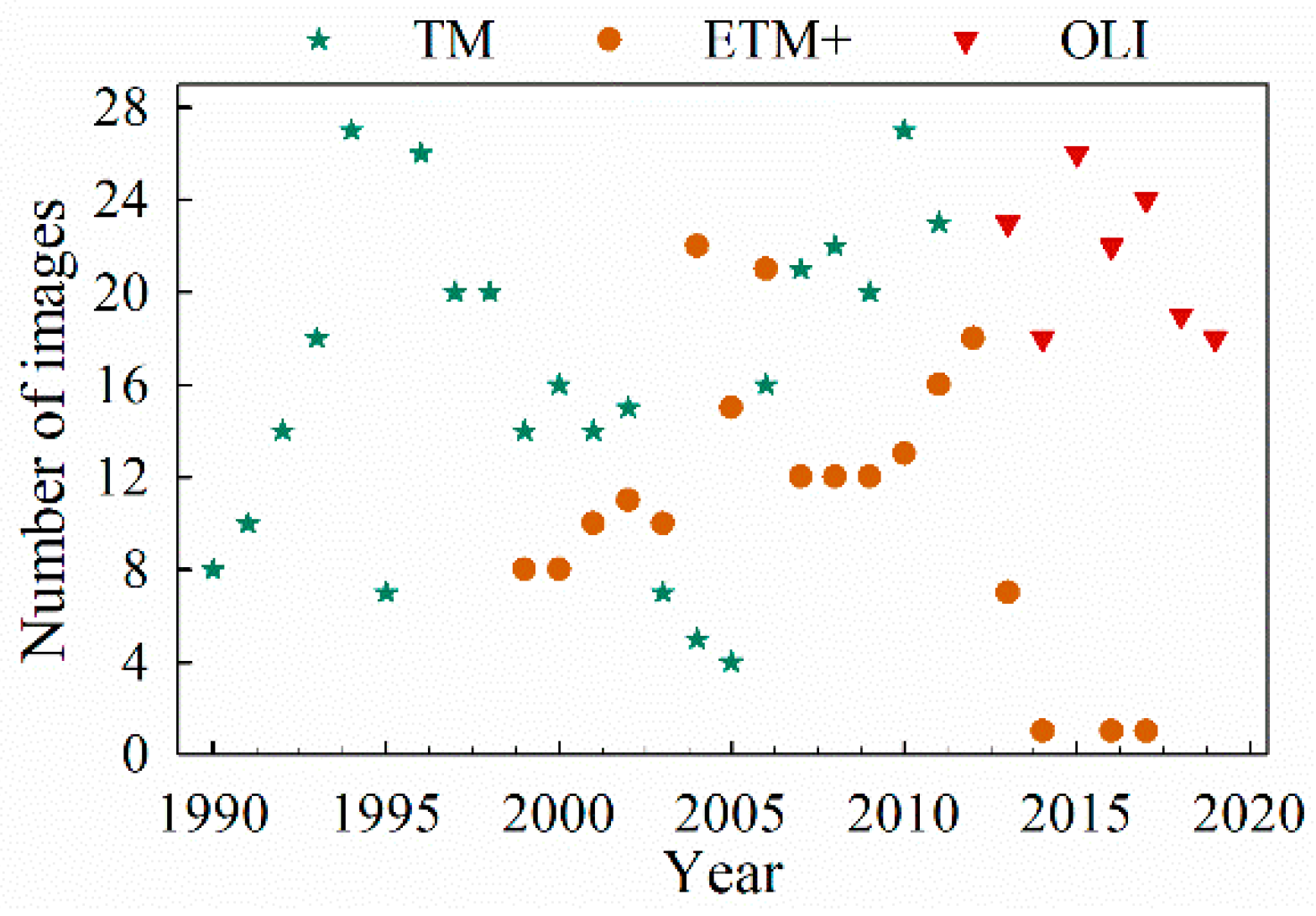
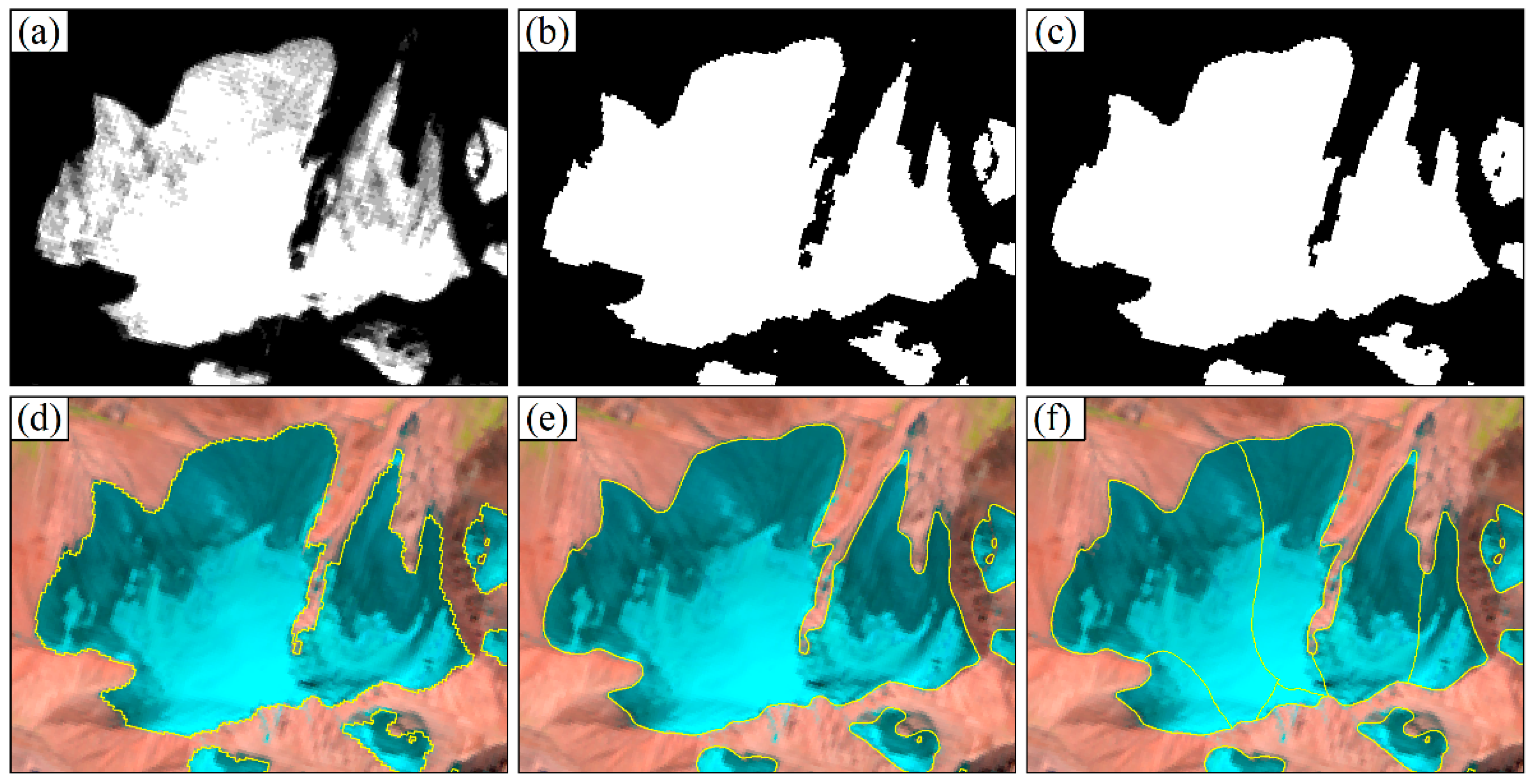
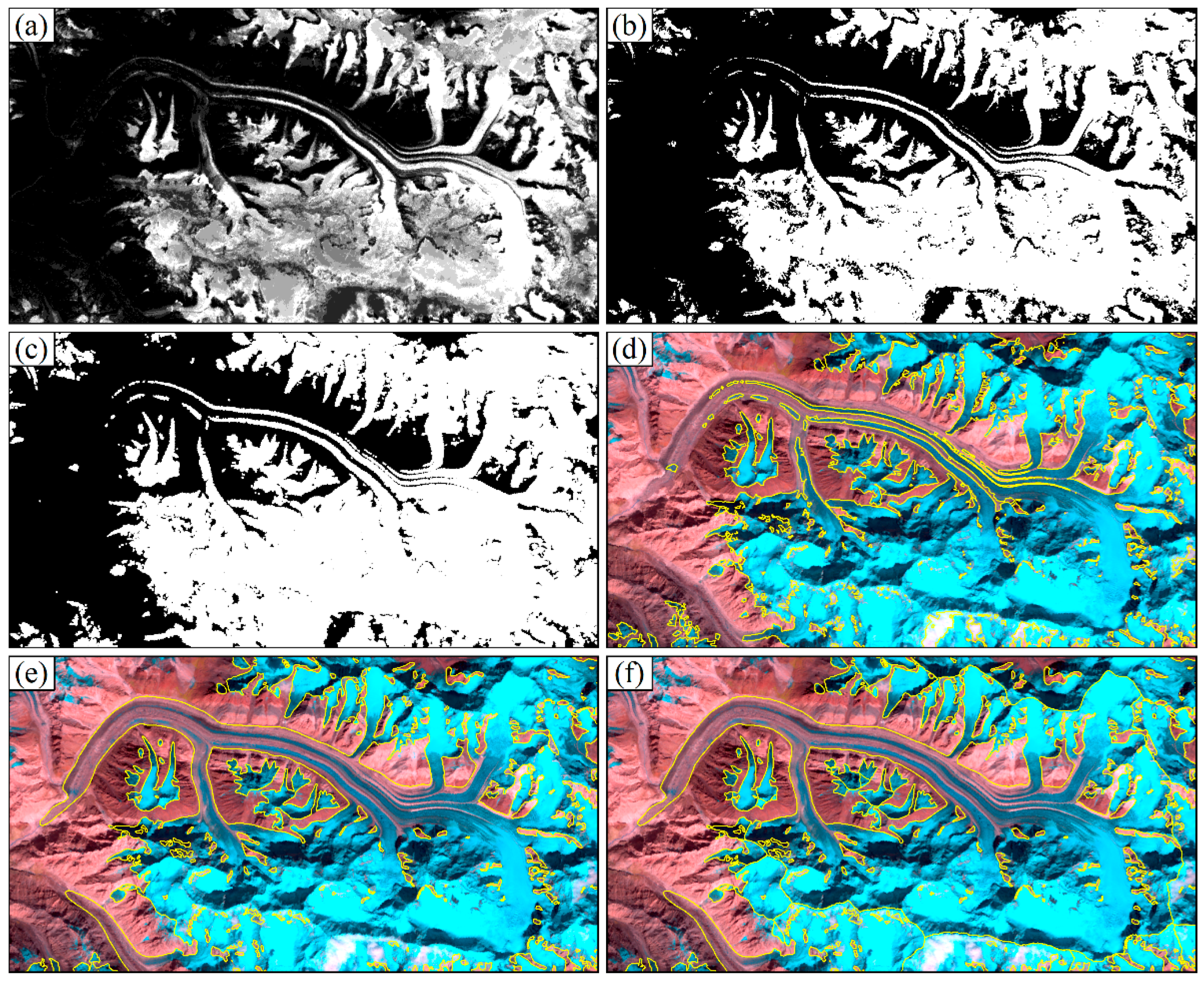
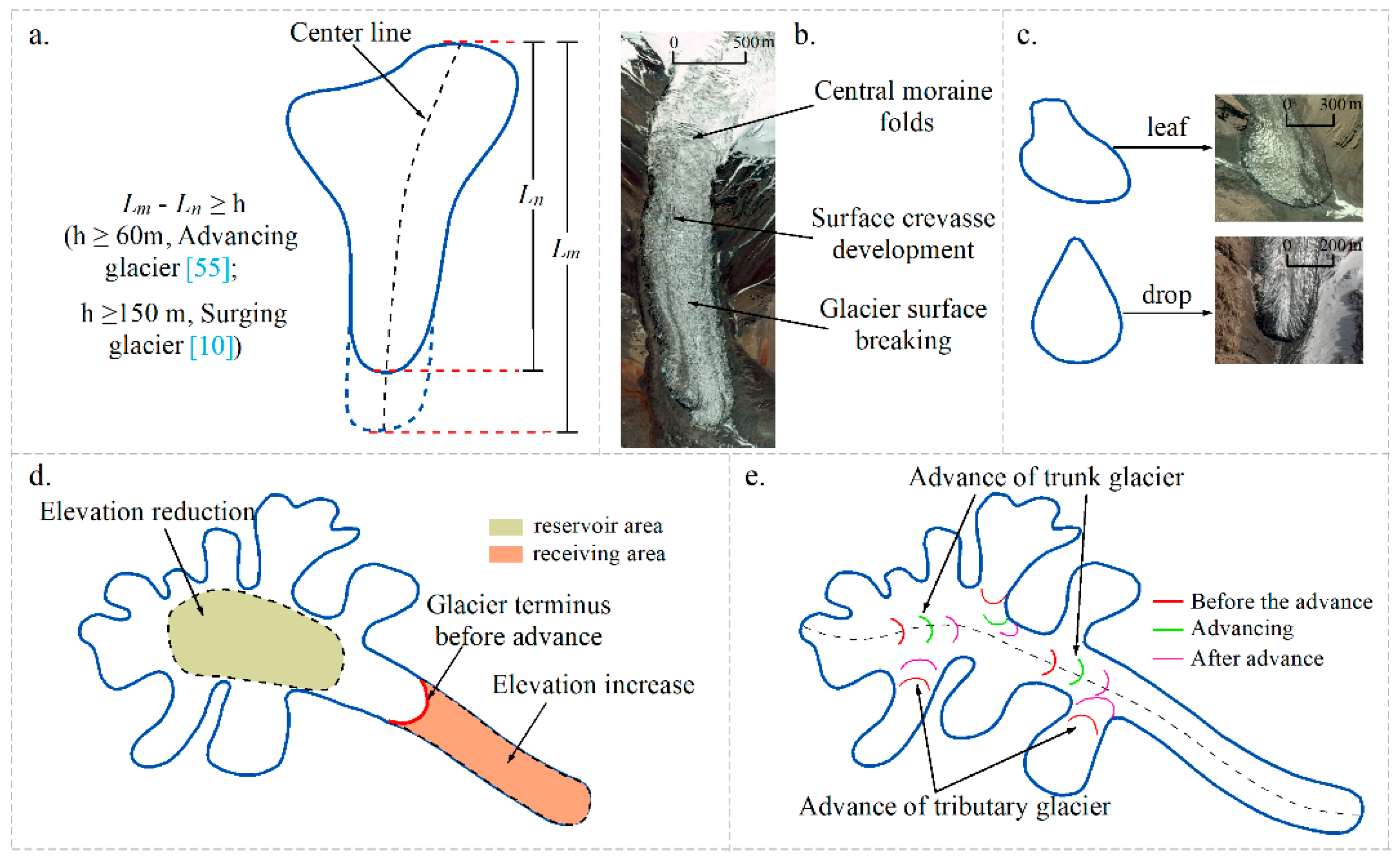
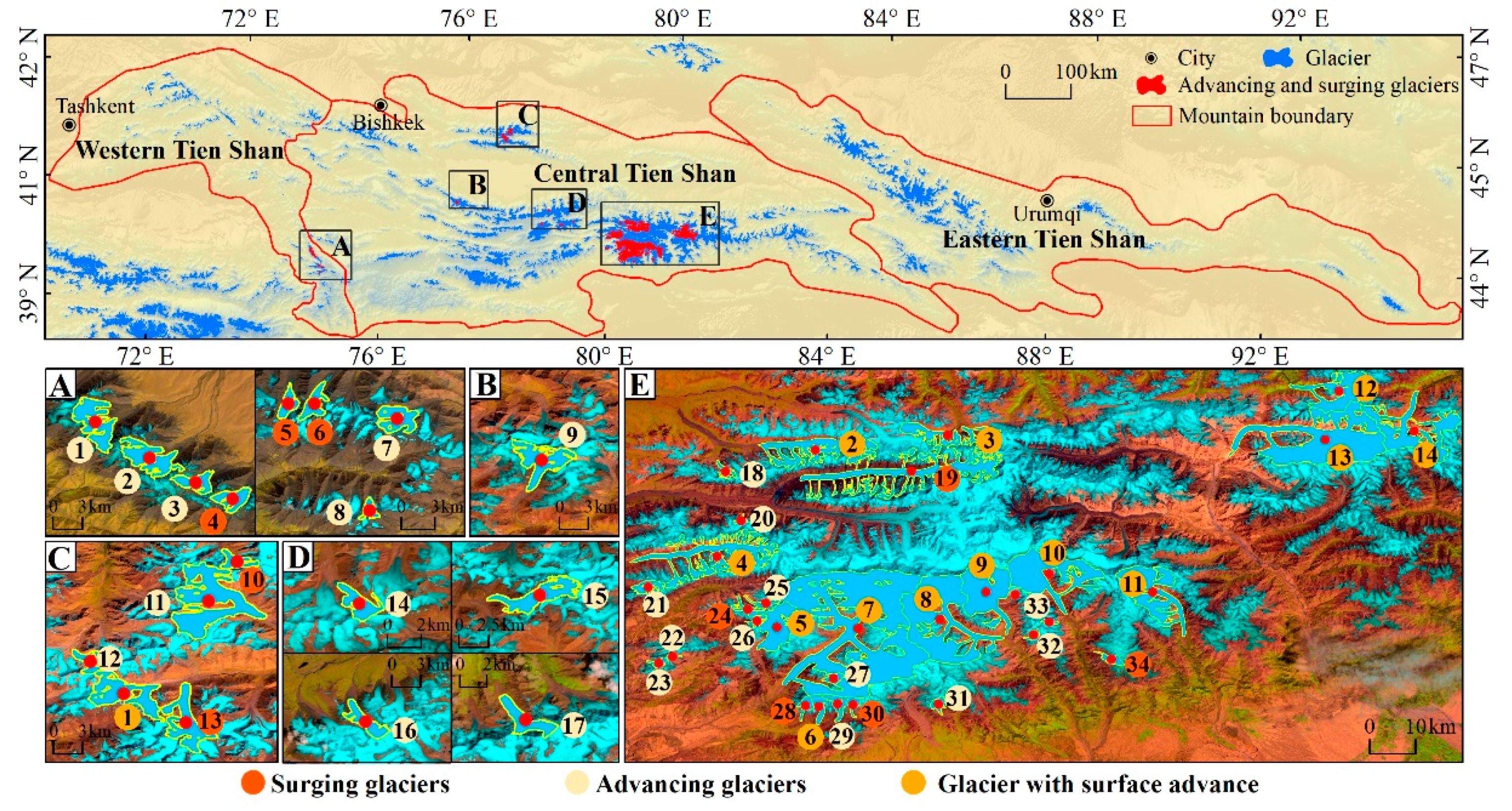
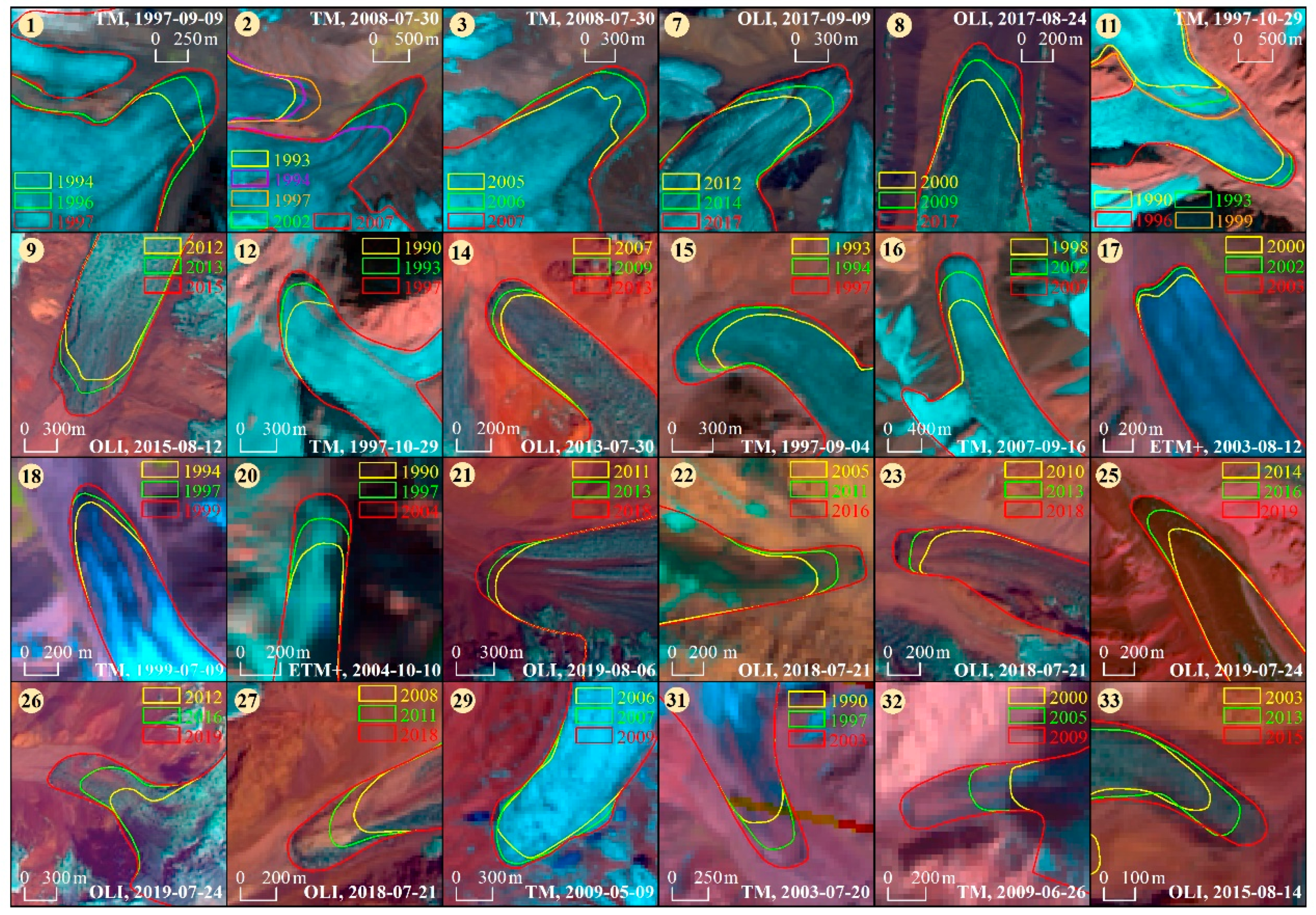



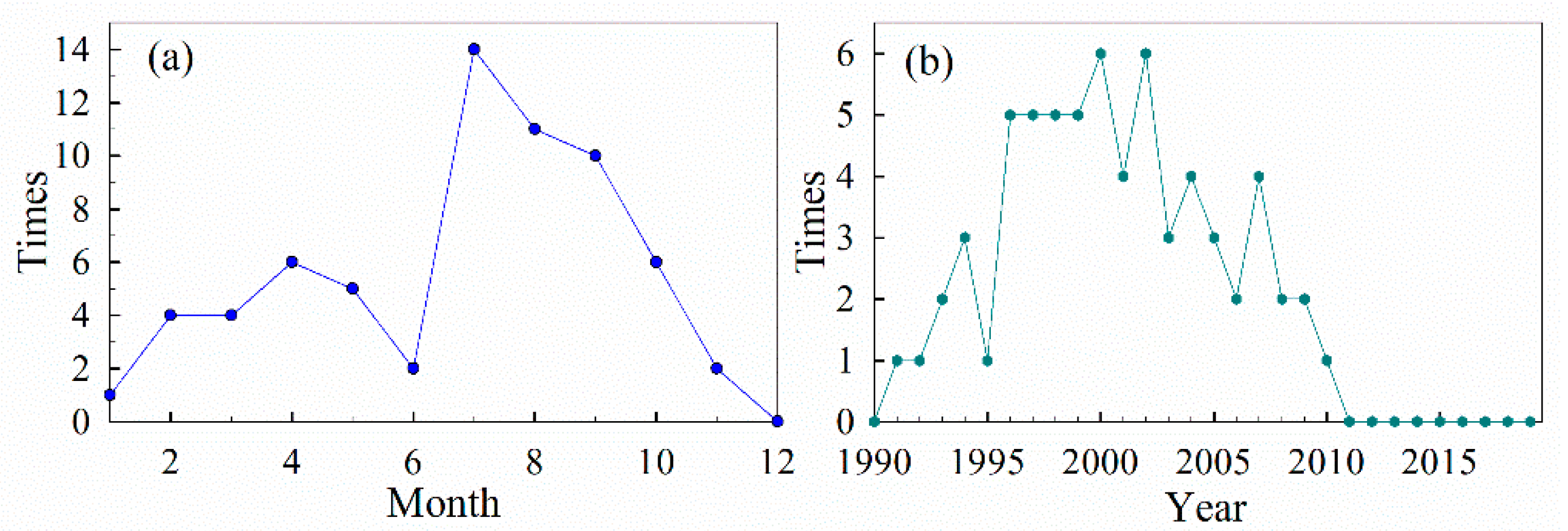
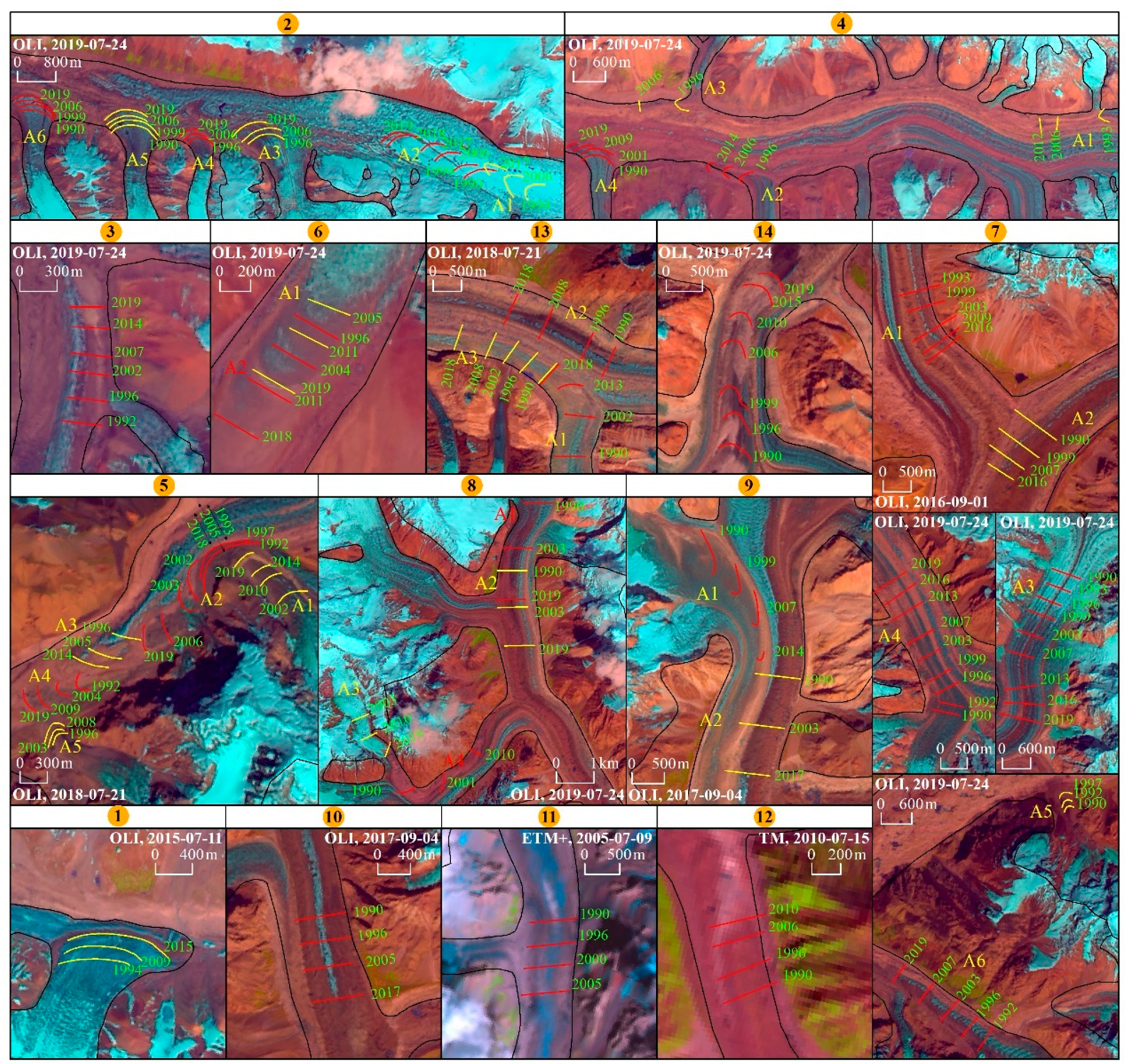
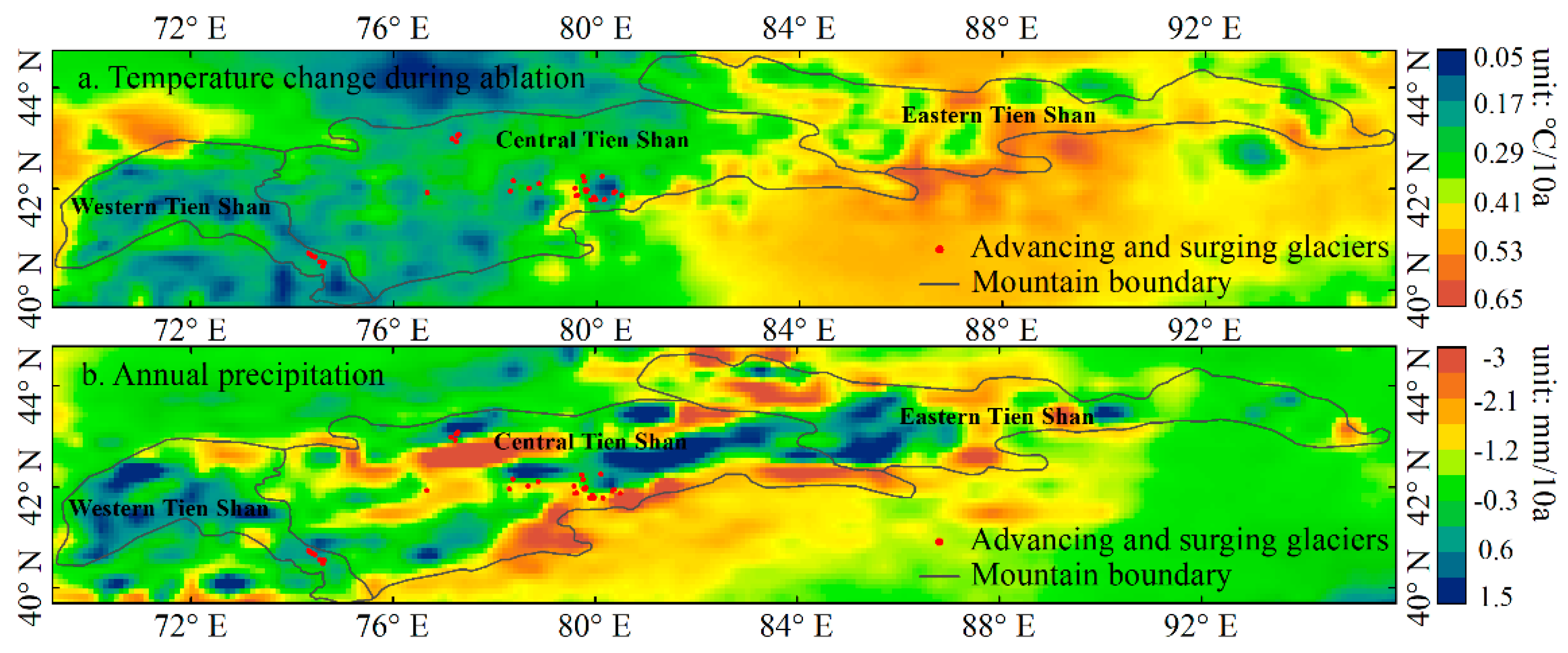

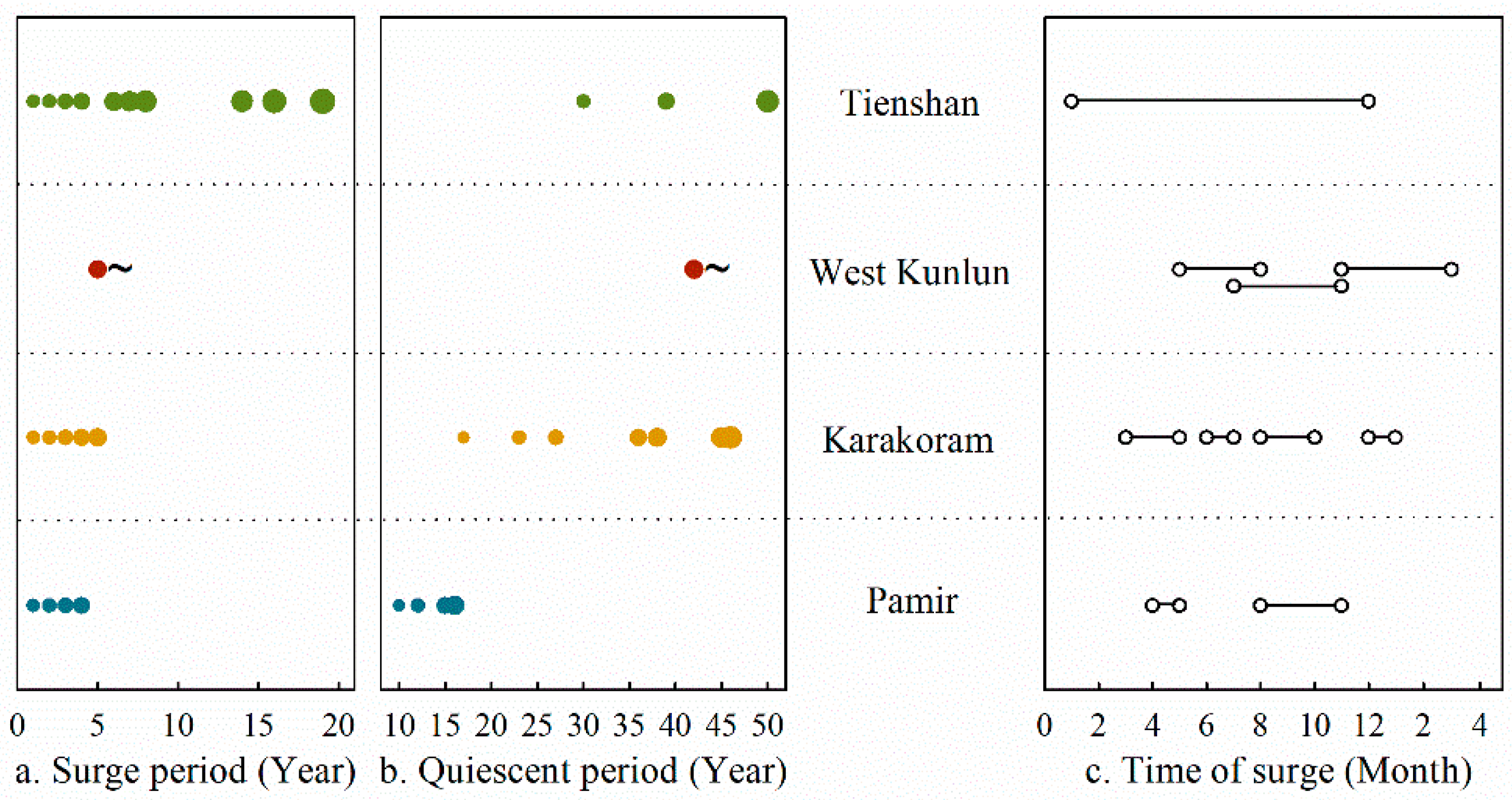
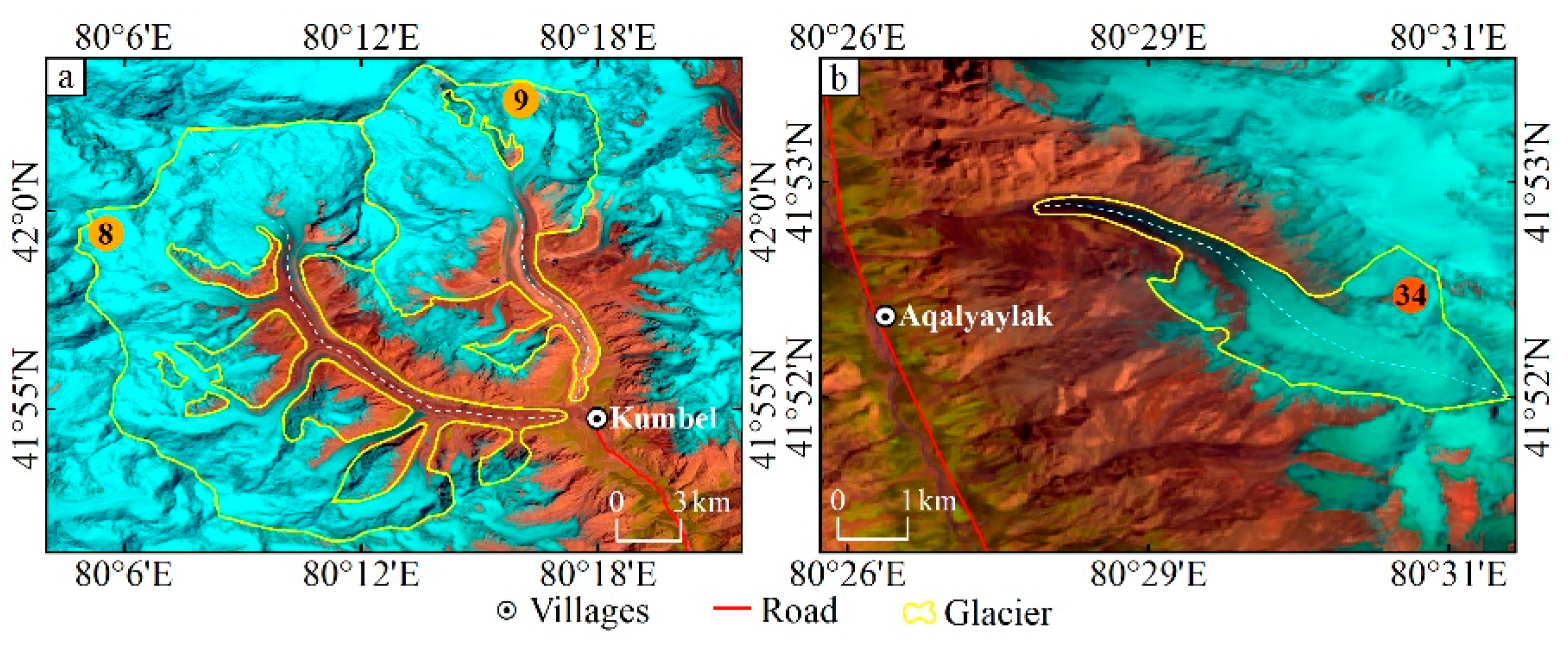
| No. | Global Land Ice Measurements from Space ID number | Name | Area (km2) | Mean Elevation (m) | Mean Slope (°) | Orientation | Advancing or Surging |
|---|---|---|---|---|---|---|---|
| 1 | G074329E40728N | ‒ | 9.86 | 4107 | 18.26 | E | advancing |
| 2 | G074380E40695N | ‒ | 9.25 | 4096 | 18.45 | NE | advancing |
| 3 | G074422E40672N | ‒ | 3.81 | 4105 | 17.86 | NE | advancing |
| 4 | G074456E40657N | ‒ | 3.99 | 4135 | 18.31 | NE | surging |
| 5 | G074571E40560N | ‒ | 2.87 | 4246 | 17.93 | N | surging |
| 6 | G074550E40560N | ‒ | 2.17 | 4056 | 14.93 | N | surging |
| 7 | G074646E40548N | ‒ | 4.46 | 4349 | 16.11 | NE | advancing |
| 8 | G074616E40475N | ‒ | 1.34 | 4250 | 16.25 | N | advancing |
| 9 | G076673E41922N | ‒ | 9.89 | 4192 | 14.04 | S | advancing |
| 10 | G077289E43078N | Shokalsky Glacier | 2.82 | 3922 | 22.36 | NW | surging |
| 11 | G077248E43020N | Bogatyr Glacier | 24.49 | 4040 | 12.40 | E | advancing |
| 12 | G077152E42985N | ‒ | 3.05 | 3973 | 19.51 | NW | advancing |
| 13 | G077241E42927N | South Jangyryk Glacier | 10.90 | 4030 | 14.80 | N | surging |
| 14 | G078877E42099N | ‒ | 1.96 | 4304 | 20.00 | N | advancing |
| 15 | G078676E42013N | ‒ | 6.72 | 4431 | 17.58 | W | advancing |
| 16 | G078307E41952N | Bezymyanny Glacier | 4.50 | 4298 | 19.02 | N | advancing |
| 17 | G078370E42156N | ‒ | 3.11 | 4017 | 21.80 | NW | advancing |
| 18 | G079736E42242N | ‒ | 5.12 | 4178 | 23.85 | N | advancing |
| 19 | G080097E42241N | Northern Inylchek Glacier | 112.88 | 4309 | 16.90 | W | surging |
| 20 | G079762E42144N | ‒ | 1.87 | 4260 | 32.89 | N | advancing |
| 21 | G079584E42014N | ‒ | 9.99 | 4398 | 22.57 | NW | advancing |
| 22 | G079632E41877N | ‒ | 2.17 | 4226 | 35.67 | E | advancing |
| 23 | G079604E41864N | ‒ | 3.57 | 4446 | 36.44 | N | advancing |
| 24 | G079781E41970N | Samoilowich Glacier | 6.72 | 4343 | 18.85 | NW | surging |
| 25 | G079816E41982N | East of Samoilowich Glacier | 6.74 | 4371 | 16.53 | NW | advancing |
| 26 | G079799E41948N | ‒ | 3.38 | 4388 | 21.32 | W | advancing |
| 27 | G079950E41834N | ‒ | 5.52 | 4436 | 33.60 | W | advancing |
| 28 | G079894E41780N | Qingbingtan Glacier | 6.60 | 4589 | 29.09 | S | surging |
| 29 | G079962E41786N | Qinbingtan No. 74 Glacier | 8.64 | 4528 | 20.53 | S | advancing |
| 30 | G079989E41783N | Kekeer Glacier | 5.01 | 4492 | 23.86 | S | surging |
| 31 | G080157E41783N | ‒ | 5.77 | 4329 | 22.35 | S | advancing |
| 32 | G080350E41918N | ‒ | 2.73 | 4605 | 29.14 | SW | advancing |
| 33 | G080375E41947N | ‒ | 1.72 | 4359 | 22.85 | E | advancing |
| 34 | G080499E41872N | ‒ | 5.71 | 4323 | 21.91 | NW | Surging |
| No. | Evidence of Surge Events | Total Length of Advance (m) | Surge Initiation (year) | Surge Termination (year) |
|---|---|---|---|---|
| 4 | Terminal advanced 208 m from 1998 to 1999; glacial surface breaking. | 511 | 1997 | 2002 |
| 5 | Terminal advanced 355 m/a; glacial surface breaking. | 710 | 2005 | 2007 |
| 6 | Terminal advanced 348 m from 2005 to 2007; glacial surface breaking. | 907 | 2002 | 2010 |
| 10 | Terminal advanced 370 m from 1994 to 1996; glacial surface breaking. | 441 | 1993 | 1996 |
| 13 | Glacier termini show clear movement in remote sensing images; glacial surface breaking. | 729 | 1996 | 2000 |
| 19 | Rapid terminal advance of 3457 m from 1996 to 1997; glacial lake disappears; glacial surface breaking. The elevation of the glacial surface is obviously thickened and thinned. | 3571 | 1995 | 1997 |
| 24 | Rapid terminal advance of 1010 m from 2003 to 2004; glacial surface breaking; surface crevasse development; terminus is leaf shaped. The elevation of the glacier surface is obviously thickened and thinned. | 2799 | 1999 | 2006 |
| 28 | Terminal advanced 181 m from 1994 to 1995; glacial surface breaking; surface crevasse development. | 537 | 1993 | 1999 |
| 30 | Terminal advanced 198 m from 1998 to 1999; glacial surface breaking; surface crevasse development. | 870 | 1998 | 2007 |
| 34 | Terminal advanced 189 m from 2001 to 2002; glacier termini show clear movement; glacial surface breaking; surface crevasse development; terminus is drop-shaped. | 1673 | 1990 | 2009 |
| No. | Global Land Ice Measurements from Space ID Number | Name | Characteristics/Description |
|---|---|---|---|
| 1 | G077183E42955N | ‒ | Tributary glacier: 360 m |
| 2 | G079906E42284N | Mushketov Glacier | Tributary glacier: A1, 997 m; A2, 1874 m; A3, 492 m; A4, 261 m; A5, 342 m; A6, 339 m |
| 3 | G080095E42328N | ‒ | Trunk glacier: 935 m |
| 4 | G079749E42092N | ‒ | Tributary glacier: A1, 1118 m; A2, 655 m; A3, 672 m; A4, 495 m |
| 5 | G079839E41935N | Ayilangsu Glacier | Tributary glacier: A1, 637 m; A2, 1312 m; A5, 133 m; Trunk glacier: A3, 526 m; A4, 589 m |
| 6 | G079925E41780N | Bingtan Glacier | Trunk glacier: A1, 605m; A2, 2837m |
| 7 | G079990E41931N | Tuomuer Glacier | Trunk glacier: A2, 1049 m; A3, 3327 m; tributary glacier: A1, 1211 m; A4, 2807 m; A5, 284 m; A6, 2119 m |
| 8 | G080154E41960N | West Qiongtailan Glacier | Trunk glacier: A1, 2685 m; A2, 2056 m; tributary glacier: A3, 1210 m; A4, 2396 m |
| 9 | G080251E42005N | Qiongtailan Glacier | Tributary glacier: A1, 1684 m; trunk glacier: A2, 1584 m |
| 10 | G080352E42043N | Keqiketieliekesu Glacier | Trunk glacier: 1029 m |
| 11 | G080581E42004N | Qiongkuziwayi Glacier | Trunk glacier: 1040 m |
| 12 | G080949E42400N | Aerqialeteer Glacier | Tributary glacier: 512 m |
| 13 | G080922E42305N | Muzhaerte Glacier | Tributary glaciers: A1, 1979 m; A3, 1715 m; trunk glacier: A2, 1706 m |
| 14 | G081078E42318N | ‒ | Trunk glacier: 2547 m |
Publisher’s Note: MDPI stays neutral with regard to jurisdictional claims in published maps and institutional affiliations. |
© 2021 by the authors. Licensee MDPI, Basel, Switzerland. This article is an open access article distributed under the terms and conditions of the Creative Commons Attribution (CC BY) license (https://creativecommons.org/licenses/by/4.0/).
Share and Cite
Zhou, S.; Yao, X.; Zhang, D.; Zhang, Y.; Liu, S.; Min, Y. Remote Sensing Monitoring of Advancing and Surging Glaciers in the Tien Shan, 1990–2019. Remote Sens. 2021, 13, 1973. https://doi.org/10.3390/rs13101973
Zhou S, Yao X, Zhang D, Zhang Y, Liu S, Min Y. Remote Sensing Monitoring of Advancing and Surging Glaciers in the Tien Shan, 1990–2019. Remote Sensing. 2021; 13(10):1973. https://doi.org/10.3390/rs13101973
Chicago/Turabian StyleZhou, Sugang, Xiaojun Yao, Dahong Zhang, Yuan Zhang, Shiyin Liu, and Yufang Min. 2021. "Remote Sensing Monitoring of Advancing and Surging Glaciers in the Tien Shan, 1990–2019" Remote Sensing 13, no. 10: 1973. https://doi.org/10.3390/rs13101973
APA StyleZhou, S., Yao, X., Zhang, D., Zhang, Y., Liu, S., & Min, Y. (2021). Remote Sensing Monitoring of Advancing and Surging Glaciers in the Tien Shan, 1990–2019. Remote Sensing, 13(10), 1973. https://doi.org/10.3390/rs13101973








